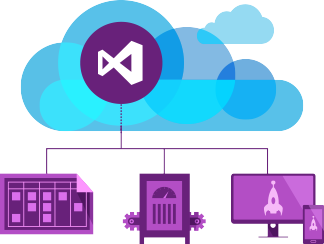There are more than 6 months from the moment when we started to use Visual Studio Online for a real project. Until then we use it only internally on small internal projects. Nothing real.
Initially I wrote a post about our first impression related to VS Online. More about this can be found on the following post http://vunvulearadu.blogspot.ro/2015/01/first-impression-of-visual-studio-online.html
Initially we started with an estimated team of 4-7 people. This was our initial estimation, 6 months ago:
Build Duration: 20 minutes
 Working window on a day: 10 hours
Working window on a day: 10 hours
Number of build per day: 30 builds
Number of developers: 4-7 people
Number of days per month: 23 days
Total minutes per month: 13.800 minutes
Minutes cost: 60 minutes free + 1140 minutes at 0.0373e + 12600 minutes at 0.0075e
Cost: 0 + 1140*0.0373+12600*0.0075
Total Cost: 137.022e
Now, let's see how reality looks like. All information is from the billing information and is 100% real. No estimations, actual facts (smile).
Costs (June):
Build time consumed in the last month: 1994 minutes - 48.81e
Basic Users: 27.39e
Total: 76.2e
Costs (May):
Build time consumed in the last month: 6006 minutes - 78.69e
Basic Users: 14.89e
Total: 93.58e
In June a new fellow joined the team and we had to increase the number allocated licences with 1 for VS Online. This is why the price of Basic Users has increased.
The number of build time minutes decreased not because we don't work anymore on the project, but because we decided to create a nightly build where integration tests are run and a light build that runs at every check-in. This is how we were able to save more than 4.000 minutes per month.
Yes, we are still under our estimations even if we have the following setup:
In this moment I would say that from the costs perspective we are in a pretty good range, in the context where we don't need and manage the source control and build server.
Initially I wrote a post about our first impression related to VS Online. More about this can be found on the following post http://vunvulearadu.blogspot.ro/2015/01/first-impression-of-visual-studio-online.html
Initially we started with an estimated team of 4-7 people. This was our initial estimation, 6 months ago:
Build Duration: 20 minutes
 Working window on a day: 10 hours
Working window on a day: 10 hoursNumber of build per day: 30 builds
Number of developers: 4-7 people
Number of days per month: 23 days
Total minutes per month: 13.800 minutes
Minutes cost: 60 minutes free + 1140 minutes at 0.0373e + 12600 minutes at 0.0075e
Cost: 0 + 1140*0.0373+12600*0.0075
Total Cost: 137.022e
Now, let's see how reality looks like. All information is from the billing information and is 100% real. No estimations, actual facts (smile).
Costs (June):
Build time consumed in the last month: 1994 minutes - 48.81e
Basic Users: 27.39e
Total: 76.2e
Costs (May):
Build time consumed in the last month: 6006 minutes - 78.69e
Basic Users: 14.89e
Total: 93.58e
In June a new fellow joined the team and we had to increase the number allocated licences with 1 for VS Online. This is why the price of Basic Users has increased.
The number of build time minutes decreased not because we don't work anymore on the project, but because we decided to create a nightly build where integration tests are run and a light build that runs at every check-in. This is how we were able to save more than 4.000 minutes per month.
Yes, we are still under our estimations even if we have the following setup:
- Number of VS Users: 9 (5 Free, 3 Paid, 1 MSDN ('free'))
- Number of project in solution: 50 projects
- Number of lines of code: 8900 lines (we excluded comments, extra space lines, usings lines and things like this)
- Number of tests: 217 tests
- Cyclomatic complexity: ~80
- Maintainability index: 87
From the usability perspective, VS Online is pretty nice. You have almost all the things that you need to be able to develop, manage and control a proiect. We still don't have an automatically deployment step after nightly build, but we are planning to add it in the near future.
In this moment I would say that from the costs perspective we are in a pretty good range, in the context where we don't need and manage the source control and build server.
Comments
Post a Comment